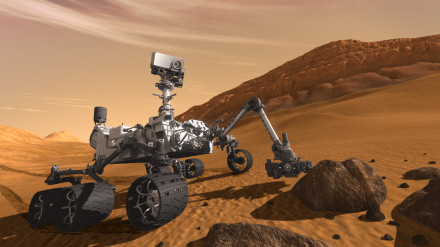The entire nation waited in anticipation as the Curiosity Mars Rover made a successful touchdown on the surface of Mars on Aug. 6 of last year. For the past nine months, Curiosity has been exploring the surface of Mars, and several exciting discoveries have already been made.
Managed by NASA’s Pasadena-based Jet Propulsion Laboratory, Curiosity’s formal mission will last one Mars year, or about 23 Earth months. According to JPL the rover is equipped with a variety of equipment, including a robotic arm, a radiation assessor, several instruments that test minerals on Mars, and multiple cameras, which have sent back many stunning pictures of the Mars landscape that can be found on NASA’s website. The rover is also equipped with a laser that can vaporize rocks from up to 30 feet away and determine what material they are made of.
The evidence that water could have formerly existed on Mars is increasing. NASA’s website states that hydrated minerals have been found in the soil of Yellowknife Bay, Curiosity’s landing site. This shows that water could have existed on Mars, and that the conditions may have been conducive to microbial life.
Chemicals such as sulfur, nitrogen, hydrogen, oxygen, phosphorus, and carbon have been found in rock samples taken from the red planet, according to NASA’s website. These are some of the building blocks of life, and are important finds. NASA speculates that the Yellowknife Bay area may once have been part of an ancient river system that provided energy for life on Mars, and stated that the next drilling project will attempt to confirm the evidence.
Curiosity has experienced some minor setbacks in 2013, but no permanent damage. After a memory glitch in its main A-side computer, NASA announced that it switched to its identical backup B-side computer in March. The B-side is now being used as the main computer, and the A-side can be accessed as a backup.
From April 4 to May 1, NASA stated that no commands were sent to Curiosity because of a Mars solar conjunction, which occurs every 26 months. This is when Mars passed almost directly behind the sun from Earth’s perspective. This can corrupt radio transmissions between the two planets. Curiosity continued to record scientific observations during April, but did not move or receive commands.
The rover is now gearing up to begin drilling for rock samples in a site named Cumberland. According to a news update on NASA’s website, JPL is hoping to confirm evidence from the first drilling that a past river system environment may have been able to sustain life. Afterwards, Curiosity will travel to the base of Mount Sharp, a three mile tall Martian mountain – taller than any mountain in the continental U.S., to study Mar’s geology.
Wherever the rover goes, discoveries are sure to be made, and the world below will be curious to see what can be learned about our neighbor the red planet.
Information accredited to the websites of NASA and NASA’s JPL:
NASA: http://www.nasa.gov

